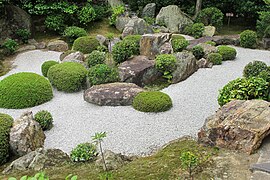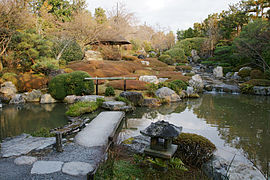Taizō-in
The Taizō-in ( Japanese 退 蔵 院 ) is a sub-temple of Myōshin-ji in Ukyō-ku , Kyōto . It is known for its diverse gardens and for having a famous Zen image.
Overview
The Taizō-in was founded in 1404 by the third head of the Myōshin-ji , Muin Sōin ( 無 因 宗 ) as one of the 46 sub-temples of the Myōshin-ji. The original complex was lost in the Ōnin war , the current buildings were built after 1600.
You enter it from the east through the simple temple gate ( 山門 Sammon ) in Yotsuashi style , pass a small building and the building with the refectory ( 庫裏 kuri ) and get to the main hall, which is also an abbey (an important cultural asset of Japan ). The temple founder Muin is venerated. In the north, the abbot's work and reception room ( 書院 shoin ) adjoins the abbot's residence , which also includes a room for the tea ceremony called Kakoi-no-seki ( 囲 い の 席 ). The latter two rooms are usually not open to the public.
A small Kare-san-sui rock garden adjoins the abortion in the west, and an extensive garden garden extends to the south .
The individual sights
- An elaborately designed entrance gate ( 袴 腰 の 大 玄関 , hakamagoshi no daigenkan ) leads to the abortion ( hōjō , 方丈 , also called hondō ( 本 堂 ) here ). This has an open walkway to the south towards the garden.
- The picture shown in the middle of the walkway is called Hyōnen-zu ( 瓢 鮎 図 ). It represents the (unsolvable) Zen task of catching a catfish ( 鮎 ) with a bottle gourd ( 瓢 ). The picture (a copy is shown here) comes from the monochrome painter of the Muromachi period Josetsu , the founder of monochrome ink painting in Japan. The hanging scroll is in the upper part of 31 learned monks, including Daigaku Shūsō (1345–1423), each signed with a saying. It is registered as a national treasure.
- "Motonobus Garden" ( 元 信 の 庭 , Motonobu no niwa ) behind the residence represents the Zen ideal of a rock garden with gravel, stones and some green behind a water basin in a very small space. The small, perfect plant comes from Kanō Motonobu (1476– 1559).
- The "garden of lasting fragrances" ( 余香庭 , Yokō-en ) was laid out in its current form in 1965 by the horticultural master Nakane Kinsaku. With cherry trees, maple and lotus, it is a beautiful sight in all seasons.
- The Yin and Yang garden ( 陰陽 の 庭 , In'yō no niwa ) is a rock garden within the Yokō-en. The system at the west end of the garden is divided into two parts: the yin side is designed with stones on dark gravel and the yang side with stones on light gravel.
- The hand basin and water harp pit ( 蹲 と 水 琴 窟 , tsukubai to suikinkotsu ) together form a resonance system that lets the sound of the falling water reverberate.
- A large traditional rest house ( 大 休 庵 , Daikyū-an ), where tea is served, also belongs to the garden .
photos
Remarks
- ↑ In the picture above 31 monks from different temples of Kyoto have immortalized themselves.
- ↑ Nakane Kinsaku ( 中 根 金 作 , 1917–1995), is considered the " Kobori Enshū of the Shōwa period ".
literature
- Folder of the temple
- Yamamoto, Jirō: Kyoto-fu no rekishi sampo (chu). Yamakawa Shuppan, 1998. ISBN 978-4-634-29560-5 .
Web links
- Taizō-in website (Japanese)
Coordinates: 35 ° 1 ′ 20 ″ N , 135 ° 43 ′ 10 ″ E







